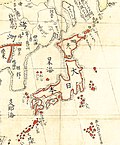Kōji (康治) was a Japanese era name (年号, nengō, lit. "year name") after Eiji and before Ten'yō. This period spanned the year from April 1142 through February...
4 KB (318 words) - 00:20, 17 July 2024
Japanese given name Kōji (Heian period) (康治), Japanese era, 1142–1144 Kōji (Muromachi period) (弘治), Japanese era, 1555–1558 Koji orange, a Japanese citrus...
755 bytes (132 words) - 12:25, 28 May 2024
recommendation of his advisor Wake no Kiyomaro and marking the beginning of the Heian period of Japanese history. According to modern scholarship, the city is thought...
15 KB (1,927 words) - 07:12, 23 October 2024
Kōji (弘治) was a Japanese era name (年号, nengō, "year name") after Tenbun and before Eiroku. This period spanned the years from October 1555 through February...
4 KB (383 words) - 23:37, 2 April 2024
Kyoto (section Feudal period)
start of the Heian period (794–1185), the city was often referred to as Heian-kyō (平安京, "Heian capital"), and late in the Heian period the city came...
72 KB (6,143 words) - 08:15, 31 October 2024
Benkan (section Heian period)
have already been present on the benkan of Emperor Shōmu, and by the Heian period (794-1185) and later, the benkan also featured a depiction of the three-legged...
34 KB (4,392 words) - 13:03, 20 September 2024
History of Japan (redirect from Kamakura–Muromachi period)
was established at Heian-kyō (modern Kyoto), marking the beginning of the Heian period, which lasted until 1185. The Heian period is considered a golden...
137 KB (16,274 words) - 10:50, 2 November 2024
Japanese garden (section Heian period (794–1185))
("lake-spring-boat excursion garden"), which was imported from China during the Heian period (794–1185). These were designed to be seen from small boats on the central...
111 KB (14,186 words) - 18:05, 5 November 2024








